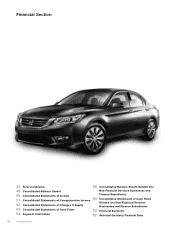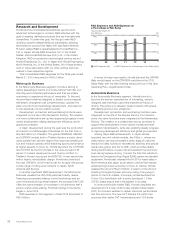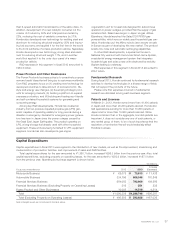Honda 2013 Annual Report Download - page 38
Download and view the complete annual report
Please find page 38 of the 2013 Honda annual report below. You can navigate through the pages in the report by either clicking on the pages listed below, or by using the keyword search tool below to find specific information within the annual report.
Research and Development
Honda and its consolidated subsidiaries use the most-
advanced technologies to conduct R&D activities with the
goal of creating distinctive products that are internationally
competitive. To attain this goal, the Group’s main R&D
divisions operate independently as subsidiaries, allowing
technicians to pursue their tasks with significant freedom.
Product-related R&D is spearheaded by Honda R&D Co.,
Ltd. in Japan; Honda R&D Americas, Inc. in the United
States; and Honda R&D Europe (U.K.) Ltd. in the United
Kingdom. R&D on production technologies centers around
Honda Engineering Co., Ltd. in Japan and Honda Engineering
North America, Inc. in the United States. All of these entities
work in close association with our other entities and busi-
nesses in their respective regions.
Total consolidated R&D expenses for the fiscal year ended
March 31, 2013 amounted to ¥560.2 billion.
Motorcycle Business
In the Motorcycle Business segment, Honda is aiming to
deliver appealing products in a timely manner that offer out-
standing environmental performance and that will enable
customers to experience the joy of ownership. To this end,
we prioritized initiatives designed to bolster product appeal
refinement, strengthen cost competitiveness, quicken the
pace of product and technology development, and respond
to the demands of a low-carbon society.
Development, production and purchasing functions were
integrated on the site of the Kumamoto Factory. The creation
of a more collaborative set-up has supported progress in new
model development, raising development efficiency, and in
global procurement.
A major development during the year was the production
and launch of middleweight motorbikes for the first time in
Honda’s factory in Thailand. The global CBR500R, CB500F
and CB500X models built in Thailand feature a newly devel-
oped parallel twin cylinder engine that improves handling at
low and medium speeds while delivering sporty performance
at higher speeds. In the U.S., Honda launched the CTX700N
and CTX700 as the first models in the new-concept CTX
series of cruisers developed around touring comfort. In
Thailand, Honda introduced the MSX125, a new sports bike
with a freshly individualistic design. Honda also launched
the new CRF250L on/off-road model for an agile ride across
a wide range of riding environments in Japan, North
America and Europe.
In another significant R&D development, the Motorcycle
Business unveiled the UNI-CUB personal mobility device.
Featuring a proprietary balance control technology and an
omni-directional driving wheel system, the compact UNI-CUB
offers the same freedom of movement in all directions that a
person enjoys while walking. Practical testing of the device
began in June 2012.
R&D expenses in this segment in fiscal 2013 amounted to
¥66.4 billion.
In terms of major race results, Honda debuted the CRF450
Rally model based on the CRF450X road bike at the 2013
Dakar Rally, with the bike finishing among the top in this race
traversing Peru, Argentina and Chile.
Automobile Business
In the Automobile Business segment, Honda’s aim is to
become the premier manufacturer of interesting, cleverly
designed cars that help customers experience the joy of
driving. The policy is to develop “great products with speed,
affordability and low CO2 emissions.”
Development, production and purchasing functions were
integrated on the site of the Suzuka Factory. For transmis-
sions, the same functions were integrated at the Hamamatsu
Factory. The creation of a collaborative set-up promises to
support the development of new vehicle models and next-
generation transmissions, while also enabling steady progress
in improving development efficiency and global procurement.
Among major R&D achievements, in Japan Honda
launched two mini-vehicle models, the N Box +, whose ver-
satile interior can accommodate a wide range of customer
needs from daily routines to recreational activities and special
needs care-giving; and the N-ONE, which provides stable
driving performance, a quiet ride and excellent fuel economy
even during highway driving. It is also the first mini-vehicle to
feature the Emergency Stop Signal (ESS) system as standard
equipment. Honda also released the Fit EV for lease sales in
North America and Japan as an electric vehicle that realizes
extremely high power economy. In the U.S. market, Honda
released the Accord Plug-In Hybrid, a version of the Accord
boasting the highest power economy rating of any plug-in
hybrid on the U.S. market. In Europe, Honda launched the
5-door Civic hatchback with a newly developed 1.6 liter
i-DTEC diesel engine that is the lightest in its class.
In other automobile-related R&D, Honda completed the
development of a new continuously variable transmission
(CVT) for mid-size vehicles to deliver improved performance
and fuel economy. The new CVT delivers 5% better fuel
economy than earlier CVT transmissions and 10% better
R&D Expenses and R&D Expenses as
a Percentage of Net Sales
Years ended March 31
Yen (billions) (%)
R&D Expenses (left) R&D Expenses as a Percentage of Net Sales (right)
200
400
600
0
3
6
9
0
09 10 11 12 13
Annual Report 201336
























